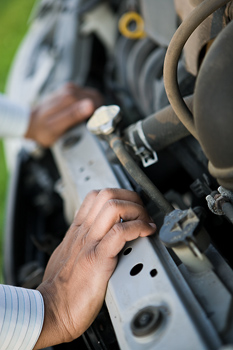How to Replace a Radiator
A properly functioning radiator is critical to the correct operation of your vehicle’s engine. A radiator dispels the heat of your engine, or radiates heat, so if your radiator is broken, your engine gets too hot and that heat damages the engine. Knowing how to replace a radiator is a crucial skill for any mechanic.
The radiator prevents the engine from overheating, by taking in hot engine coolant and channeling it through a series of tubes. This is done in order to cool down, so the coolant can be re-circulated through your engine, to prevent major damage from occurring due to overheating issues.
But what do you do when your radiator needs to be replaced? The prudent choice would be to take it to a certified automotive repair center. Certified mechanics replace radiators all the time, according to the factory specifications set forth by the automotive manufacturer that produced your vehicle.
Why Hire a Mechanic?
Unless you’ve been around car motors your whole life, or you have training as a mechanic, performing your own serious motor engines repairs is like those old Holiday Inn Express commercials, where the guy thinks he can perform open heart surgery, because he was smart enough to choose the right hotel. Believe me, you don’t want to stay at that Holiday Inn Express.
However, if money is an issue, learning how to replace a radiator is an option. Replacing a radiator can be a complicated procedure, depending on the type of car that you have, but at least you’re not trying to replace the head gasket or engine block.
Remember, replacing a radiator and failing can cause more damage to your car or injury to yourself. Make sure that you’re familiar with all the aspects of car repair, before attempting to replace a radiator. These instructions alone may not be enough to ensure that you perform such a task.
Step 1
Consult an automotive repair manual to familiarize yourself with where your radiator is located, as well as the other cooling system components. Do not remove the radiator cap until the car has cooled down. Otherwise, the cap is under a lot of pressure and could burst, causing blunt force trauma and severe burns from the hot coolant spraying out.
For the most part, the radiator is located in the front of the engine cavity.
Step 2
Disconnect the negative battery terminal to make sure that there are no accidental grounding issues. While you do this, don’t allow the wrench to contact the positive terminal, as this can result in the battery exploding and spraying acid everywhere.
When I used to volunteer in an emergency room, a guy came in one day who had touched his wedding ring to part of a car engine, and he severely burned his finger, where the wedding ring touched his skin. All he was doing was trying to loosen something with a screw driver, but the battery was still connected, sending jolts of electricity into whatever he had touched. Just keep that in mind when deciding whether to unhook the battery or not.
Once this safety precaution has been completed, you are ready to proceed.
Step 3

How to Replace a Radiator
Turn the radiator drain valve in a counter clockwise direction, to allow the radiator fluid to drain out. Some vehicle models have radiator and fan mounts, which are located in the way of the hose connections and the drain valve. If this is the case, remove these bolts to allow you to access them.
Once the fluid has drained out, remove the lower hose connections. After removing the lower fan bolts and lower hose connections, remove the upper hose connections and fan bolts
Step 4
Find the radiator mounting bolts and remove them. Keeping the fan out of the way, remove the radiator from the engine cavity. Check to make sure that no unwanted debris has fallen into the space previously occupied by your radiator.
Step 5
Check to make sure that the radiator was not damaged during shipping. Affix the cooling fan assembly to the radiator, making sure that the fans are not impeded by anything, and that the whole assembly is clean and free of debris.
Step 6
Re-connect the hoses, bolts and mounts. Once this is done, make sure that everything is put back properly or, better yet, consult a certified mechanic or official automotive repair manual that is pertinent to your vehicles’ particular make, model and year.
After consulting sources outside this article and making sure everything is in place, fill the radiator with coolant or a mixture of coolant and water and start the engine, leaving the radiator cap off. Let the engine warm up a bit, then replace the cap.
Check to make sure coolant is not leaking out. Make sure that the reservoir is at least half full with coolant when warm. Check again, after the engine cools down.
Dispose of the old engine coolant, as coolant is toxic. Dumping coolant into the ground is a mistake, since the toxic coolant makes its way into the groundwater supply and poisons it.
The responsible thing to do is to take it to a specialized treatment facility. Consult your local automotive repair shop or recycling facility for tips on where to take the old coolant, as well as for advice on how to replace a radiator.
Remember, it’s important to wear proper protection such as gloves and safety glasses throughout the procedure.
